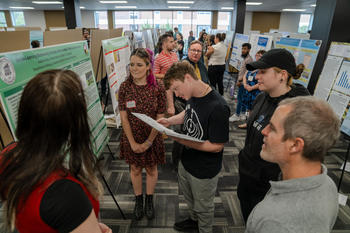
Hunter Ivey has always been fascinated with insects––most recently, fire ants and honeydew insects. Ivey’s eyes lit up as the UNC Pembroke junior was probed about his years-long research studying the dietary relationships between the minuscule bugs and invasive plants native to longleaf pine savannas in North Carolina.
When ryegrass showed up in the fire ants’ diets, the discovery piqued his curiosity. Ryegrass isn’t naturally found in longleaf pine savannas.
“We believe that honeydew insects––which are small flying insects that suck sap out of plants––are leaving the sites, feeding on ryegrass from nearby agricultural fields, then flying back to our sites and excreting honeydew that ants would capitalize on,” Ivey said.
Ivey’s excitement reached a new high when the opportunity arose to present his research before a roomful of his fellow undergraduate researchers and faculty mentors. Ivey was among a record 130 presenters at the 18th annual Pembroke Undergraduate Research & Creativity (PURC) Symposium. The Mary Livermore Library was abuzz with chatter as student scholars engaged in impromptu Q&As about broad-ranging research from field ecology, molecular biology, 3D printing, and physiology genetics to reproductive studies in cattle. While PURC is traditionally dominated by the physical sciences, art and humanities faculty are encouraging more of their students, like first-time presenter Ray Eddy, to participate.
Eddy, a sophomore studio art major who began writing poetry in middle school, displayed an interactive book-binding printmaking and poetry exhibit. Her book of confessional poetry is made entirely from cyanotype prints––one of the oldest forms of printmaking––which uses paper coated with a solution of iron salts.
“This has been an amazing opportunity,” Eddy said. “This is a type of feedback or critique I don’t get in my art classes. It’s great to receive perspectives from people who are from all fields. That’s one of the things I appreciate about the symposium.”
Eddy recited a passage from her book ‘Dirty Laundry’ during the entertainment portion of the symposium, which also featured an original composition by music major Silas Seigler.
This year’s showing represented the most student presentations in the history of the PURC Symposium––very different from the two dozen academic posters when it began in 2006, according to PURC center director Brandon Sanderson.
The PURC center supports and promotes inquiry, discovery and creativity in scholarship and the arts through mentored research experiences with faculty and other regional, national and international scholars and professionals. The center facilitates and coordinates preparation in research skills necessary for professional fields and graduate study.
“PURC is for students who want to go above and beyond in the classroom,” Sanderson, a longtime art professor. “If they want to go to graduate school, we provide grants and faculty mentoring opportunities to help them compete with bigger, more prestigious universities to get into programs.
“I find it to be one of the rewarding aspects of my service as a faculty member and as the director because it translates directly into excellent student outcomes,” Sanderson added.
During this academic year, PURC-funded students received support to conduct research through 17 fellowships and presented research and creative works at three international, 20 national and 13 regional conferences. Ivey presented his independent research at the Joint Annual Meeting of the Entomological Society of America, Entomological Society of Canada, and Entomological Society of British Columbia in Vancouver, Canada.
“I met some amazing people, made some contacts and built connections,” Ivey said. “The chance to present to people in the entomology field from all over the world was a once-in-a-lifetime opportunity.”